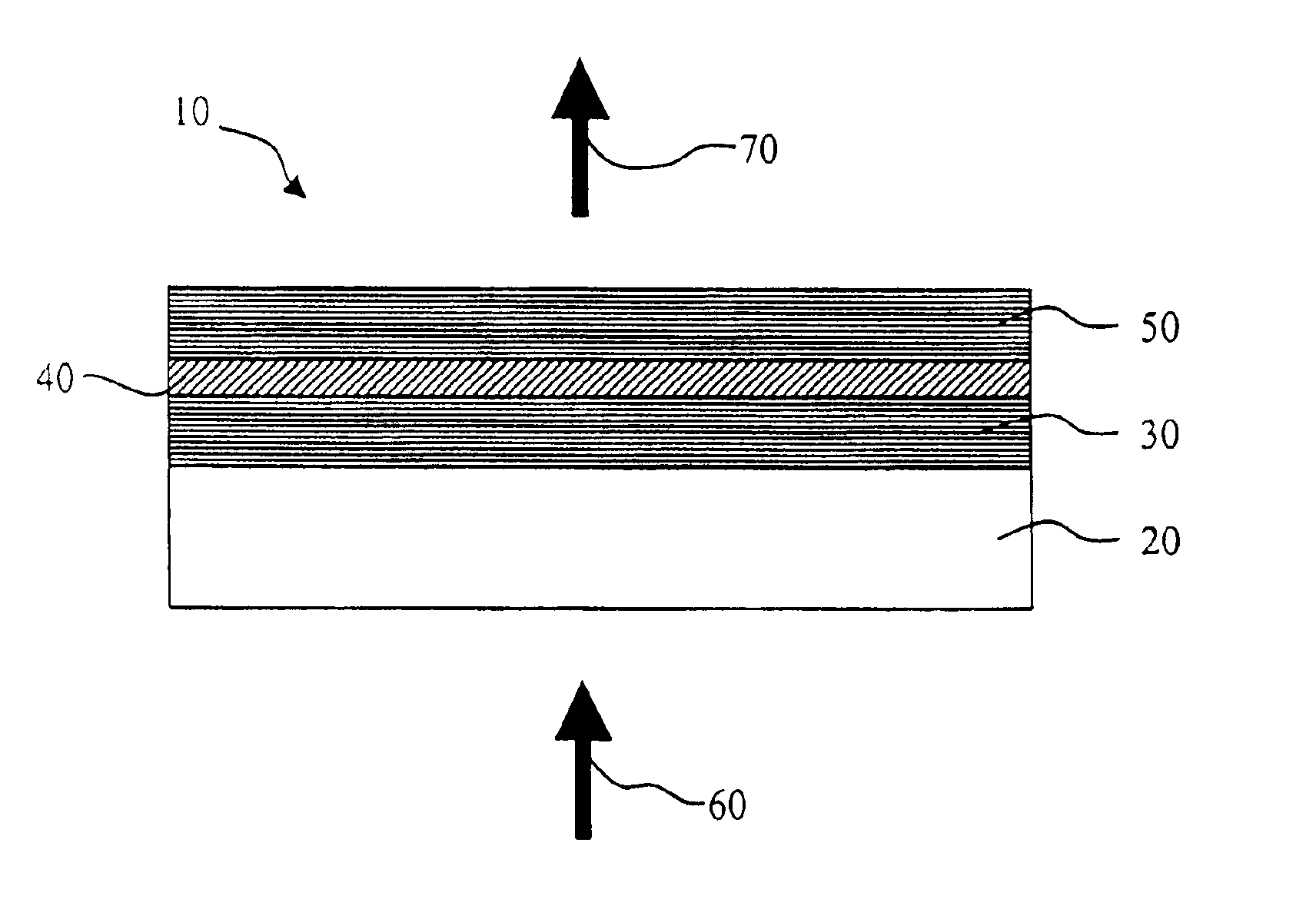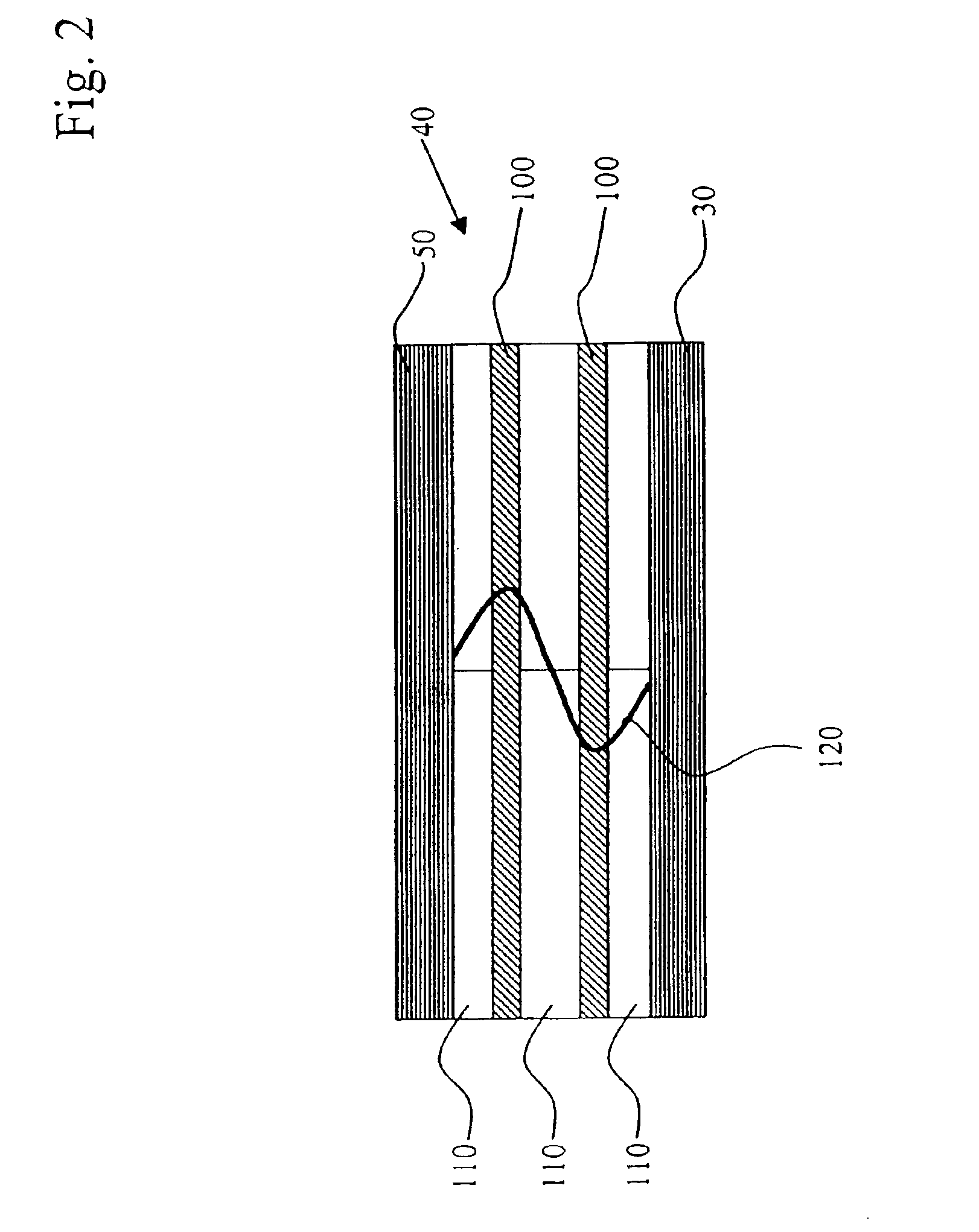Organic vertical cavity lasing device having organic active region
- Summary
- Abstract
- Description
- Claims
- Application Information
AI Technical Summary
Benefits of technology
Problems solved by technology
Method used
Image
Examples
example 1
Solution Ultaviolet (UV) absorption spectra and fluorescent emission spectra of materials demonstrate useful dopant and host materials. The solution UV absorption spectra and fluorescent emission spectra of representative materials are given in FIGS. 3-46. All solution spectra are from ethyl acetate solutions with the exception of L59 (THF), L60 (water) and L62 (sucrose octaacetate).
The Table indicates overlap of the emission of the host material with the absorbance of the dopant materials. An “X” indicates at least 5% host emission relative to local emission maximum at a wavelength that has at least 5% dopant absorbance relative to local absorbance maximum. A “0” indicates no (or less) overlap.
TABLEHosts:F2CO1DPPAD1D4D2Dopants:XXXXXXL56XXXXXXL2XXXXXXL5XX00XXL60XXXXXXL1XXXXXXL50X0XXXXL52XXXXXXL58X0XXXXL39XXXXXXL30XXXXXXL57XXXXXXL47XXXXXXL59XXXXXXL61XXXXXXL62XXXXXXF2na0XXXX
Clearly there are numerous combinations of host and dopant materials where the emission of the host material ove...
example 2
To test the devices for both their spectral and power characteristics, an organic vertical cavity laser structure 10 was deposited on a 4-inch silicon substrate. Over the substrate was deposited, by conventional electron beam deposition, the bottom dielectric stack 30, which was composed of alternating low and high refractive index layers of SiO2 and TiO2, respectively. The bottom dielectric stack had a peak reflectance of ˜99.95% at 660 nm. On top of the bottom dielectric stack was deposited, by high-vacuum thermal evaporation, the active region 40. The composition of the active region was 190 nm of TAPC, 20 nm of Alq plus a dopant, and 188 nm of TAPC. In one example, the dopant was L39 at a concentration of 1%; while, for the other case the dopant was L62 at a concentration of 0.5%. Following the active region 40 was deposited the top dielectric stack 50 composed of alternating layers of SiO2 and TiO2, such that its resulting measured peak reflectance was 99.85% at 660 nm. The top...
example 3
In this example, a comparison was made for laser devices containing green dopants. The device structure was analogous to that of Example 2, except the thicknesses of the active region layers were 137 nm of TAPC, 50 nm of Alq plus a dopant, and 122 nm of TAPC. The four dopants for this example are 0.5% of L30, 0.75% of L55, 0.75% of L54, and 0.75% of L53. The bottom dielectric stack 30 had a peak reflectance of ˜99.98% at 560 nm, while the top dielectric stack 50 had a peak reflectance of ˜99.3% at 560 nm. At a pump-beam power density on the device surface of ˜10 W / cm2, the measured spectral and intensity characteristics for the four cases are given in the table below.
EmissionActive RegionIntensityLinewidthwavelengthIntensitydopant(5 KHz)(5 KHz)(5 KHz)(5 MHz) 0.5% L3051861.3 nm562 nm51 × 1050.75% L5535221.2 nm567 nm30 × 1050.75% L5451001.4 nm557 nm41 × 1050.75% L5344001.1 nm562 nm37 × 105
As can be seen from the table, the device containing the L30 dopant produced the most intense las...
PUM
| Property | Measurement | Unit |
|---|---|---|
| Nanoscale particle size | aaaaa | aaaaa |
| Nanoscale particle size | aaaaa | aaaaa |
| Fraction | aaaaa | aaaaa |
Abstract
Description
Claims
Application Information
 Login to View More
Login to View More - R&D
- Intellectual Property
- Life Sciences
- Materials
- Tech Scout
- Unparalleled Data Quality
- Higher Quality Content
- 60% Fewer Hallucinations
Browse by: Latest US Patents, China's latest patents, Technical Efficacy Thesaurus, Application Domain, Technology Topic, Popular Technical Reports.
© 2025 PatSnap. All rights reserved.Legal|Privacy policy|Modern Slavery Act Transparency Statement|Sitemap|About US| Contact US: help@patsnap.com



